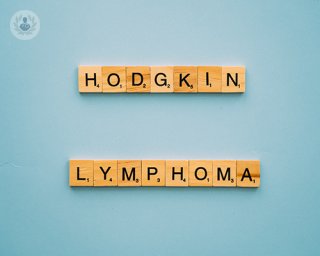Hodgkin's disease
Dr Michael Potter - Haematology
Created on: 03-12-2013
Updated on: 10-18-2023
Edited by: Conor Lynch
What is Hodgkin's disease?
Hodgkin's disease or Hodgkin's lymphoma is a type of lymphoma, a cancer that originates in white blood cells or lymphocytes (defence cells of the immune system). It is a cancer of the lymphatic system, which is a network of organs, lymph nodes, ducts, and lymphatic vessels that produce lymph and transport it from the tissues to the bloodstream, which is essential for the immune system.

In Hodgkin's lymphoma, uncontrolled atypical lymphoid cells, called Reed-Sternberg, cause enlargement of the lymph nodes in a particular area, progressively moving to other nearby areas, such as the spleen or bone marrow. Although Hodgkin’s disease can originate almost anywhere, it usually appears in the lymph nodes in the upper part of the body: in the chest, neck and/or armpits.
Hodgkin's lymphoma is rare, accounting for less than one per cent of all new cancer cases in the UK. However, incidence rates have increased over the last decade, and there are around 2,100 new cases every year. It affects men more often than women.
According to the World Health Organization (WHO), Hodgkin's lymphoma can be divided into two main types:
Classic Hodgkin's lymphoma
This is the most common form of the disease (80 per cent of cases), and can be further divided into the following sub-categories:
- Classic Hodgkin's lymphoma rich in lymphocytes (10 per cent of cases)
- Hodgkin's lymphoma with nodular sclerosis. This is the most frequent type (55 per cent of cases), affecting, above all, adolescents and young adults.
- Hodgkin's lymphoma with mixed safety (16 per cent of cases)
- Hodgkin's lymphoma with lymphocytic depletion. Common in patients with human immunodeficiency (HIV) (one per cent of cases)
Nodular lymphocytic predominance
This form of the disease accounts for 20 per cent of cases.
What are the main symptoms of Hodgkin's disease?
The most prevalent symptom of Hodgkin's lymphoma is a generally painless swelling which appears in the neck, armpit, or groin. The swelling, while not painful, can ache. It is caused by an excess of lymphocytes collecting in one of the lymph nodes.
Swollen lymph nodes, however, are not generally an indication of Hodgkin's lymphoma, as the lymph nodes will often swell in response to infection. Other symptoms of Hodgkin's lymphoma include:
- weight loss
- night sweats
- a cough that won’t go away
- feeling breathless
- skin all over the body itching
- high temperature
Certain symptoms may appear depending on the lymph nodes affected.
What are the main causes of Hodgkin's disease?
The causes of Hodgkin's disease are currently unknown. However, it is considered that an infection related to the Epstein-Barr virus, such as glandular fever, contributes to its appearance in certain cases. Likewise, people with HIV are at greater risk than the general population as HIV weakens the immune system.
Can Hodgkin's disease be prevented? If so, how?
The few known risk factors for Hodgkin's lymphoma cannot be prevented, and therefore, the condition itself generally cannot be prevented. HIV infection is known to increase the risk of developing Hodgkin's lymphoma, so avoiding risk factors associated with HIV can limit the risk of Hodgkin's lymphoma.
How is it treated?
The treatment of Hodgkin's disease varies according to the extent of the lymphoma, but it is most commonly based on chemotherapy, or chemotherapy followed by radiotherapy. In very few cases, chemotherapy is combined with steroid medication.
The overall prognosis for Hodgkin's lymphoma is generally good, providing the right treatment is given, and that the condition is detected early enough. Most of those with Hodgkin's lymphoma are cured.
How is Hodgkin's lymphoma diagnosed?
Firstly, before any diagnosis is officially made, the patient will be asked about their medical history, before a thorough and comprehensive physical examination is carried out. The patient, if reporting severe or worrying Hodgkin's lymphoma-related symptoms, will then be referred to hospital, where he or she will have a lymph node biopsy, where some or all of the affected lymph node will be removed and studied extensively by a pathologist.
The pathologist will then look for cancerous cells in the lymph node extraction, and if cancer is detected, the patient will also be informed which type of Hodgkin's lymphoma it is, in order for the appropriate treatment to be chosen.
What happens after Hodgkin's lymphoma is diagnosed?
Once the diagnosis is confirmed, further tests will be required in order to find out how far the Hodgkin's lymphoma has spread in the individual's body. These tests typically include blood tests, a chest X-ray, a CT scan, a bone marrow sample, an MRI scan, and a PET scan.

Are there any long-term complications of Hodgkin's lymphoma?
Unfortunately, some patients, even after being cured of the cancer, can suffer from long-term complications as a result of having Hodgkin's disease. The main complications include the following:
- weakened immune system
- infertility
- a high risk of getting other cancers, such as leukaemia, breast cancer, and lung cancer
- a high risk of suffering from lung disease and/or cardiovascular disease
Does Hodgkin's disease cause skin rash?
Skin rash and skin irritation are, in fact, quite rare symptoms of Hodgkin's lymphoma. Occasionally, the condition can lead to skin itchiness, without a rash.
What is the difference between Hodgkin's lymphoma and non-Hodgkin's lymphoma?
The only difference is that Hodgkin's lymphoma cells look very different compared to non-Hodgkin's lymphoma cells when analysed closely under a microscope.
Can Hodgkin's disease be cured?
Yes, Hodgkin's disease can indeed be cured, even if diagnosed at an advanced stage.
What is the difference between lymphoma and leukaemia?
Both blood cancers are very similar, particularly in the sense that, in both, white blood cells grow out of control, crowding out the healthy ones. However, the main difference centres on where exactly the cells are found. If they are found in the blood, leukaemia is diagnosed, whereas lymphoma is diagnosed when the cells are found in the lymph nodes.










